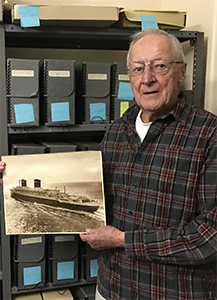Robert Sturm, a 1956 U.S. Merchant Marine Academy graduate, spends every Thursday back on campus at Kings Point, N.Y.
It’s not nostalgia that draws the 82-year-old Long Island resident to make the hour drive. It’s the American Merchant Marine Museum located on the academy grounds — and specifically its collection of documents and photos of United States Lines vessels.
Sturm had a long career in the transportation industry, including two years as a junior engineer aboard the iconic ocean liner SS United States, the flagship of United States Lines. He recently published a book, SS United States: The View from Down Below, about the ship and his 44 trans-Atlantic voyages from 1957 to 1959.
Most of his career — 44 years — was with the Long Island Rail Road, its parent Metropolitan Transportation Authority and an engineering consulting firm. He is currently writing a book on the railroad’s history after two volumes on New York rail history. But he takes a weekly break from writing to travel to the museum to serve as a volunteer archivist. His role is to organize and catalog boxes of documents and photographs the museum acquired when United States Lines sailed into oblivion in 1992.
 |
|
SS United States still holds the record for fastest trans-Atlantic passage by a ship. |
The files of the most interest, naturally, are those about SS United States. “The ship is the epitome of American genius when it comes to naval architecture and marine engineering, both in design and construction and in operation,” he said with obvious affection. “It was truly a magnificent piece of work.”
United States, launched in 1952, was the most glamorous and fastest passenger ship in the world. The 990-foot vessel was designed as part of a top-secret Pentagon program during the Cold War so it could be quickly converted from a luxury liner into a naval troopship. The maiden voyage from New York to Southampton, England, was accomplished in only three days, 10 hours and 40 minutes, and United States still holds the Blue Riband record for the fastest trans-Atlantic voyage by a ship.
The liner was taken out of service in 1969 and the rusting hull has been moored in Philadelphia for nearly two decades. The SS United States Conservancy, which owns the vessel, is trying to have the ship redeveloped as a mixed-use attraction.
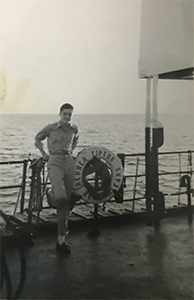 |
|
Sturm is shown aboard the Lykes Brothers freighter Reuben Tipton, on which he served as a midshipman during Sea Year. He’s currently working on a 30-inch model of the ship. |
Sturm wrote the 89-page self-published book at the suggestion of conservancy Executive Director Susan Gibbs, granddaughter of William Francis Gibbs, who designed the ship. “Bob Sturm offers a riveting account of more than the ship’s rivets: He explains how the SS United States’ top-secret engines worked and why they were so unique,” Gibbs said.
Joshua Smith, interim director of the museum, said Sturm has “deep interest and incredible experience” in the maritime industry, especially on SS United States, and it’s proven valuable.
“We’ve got this huge collection of papers from United States Lines, which was the pre-eminent American steamship company in the mid-20th century, and it’s completely unorganized,” Smith said. “When the company went bust, staff from the museum went and just grabbed filing cabinets full of stuff from their headquarters at the foot of Broadway in Manhattan. They were sitting here moldering, and what Bob is doing is very carefully going through them, box by box, and listing the contents and organizing them so they will become a useful collection that scholars and others can use. He knows the ship already, so when he reads about a person, he probably knew that person. That really adds something that nobody else could do.”
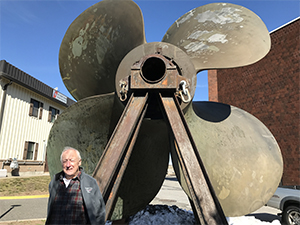 |
|
Sturm stands with a propeller from SS United States that was given to the American Merchant Marine Museum in 1993. The ship was fitted with four propellers: two four-bladed and two five-bladed. |
Sturm started going through the boxes a year ago and figures he’s got another year before he finishes.
As a Kings Point midshipman, Sturm spent his Sea Year as an engineering officer aboard ships operated by Lykes Brothers, Mississippi Shipping, Socony-Mobil and United States Lines. After graduation, he worked on United States Lines freighters for a year before being transferred to United States. The huge ship was a challenge.
“It was like a city with a large staff, including 50 engineers,” recalled Sturm, who was a junior third assistant engineer. “It was a little daunting at first.”
Twelve engineers would be on duty at any time. Working four hours on and eight hours off, they supervised firemen, oilers and wipers, who did mostly painting and cleaning, and two machinists. “There was a comfortable environment in the engine room — lots of space,” he said. The temperature was a constant 85 degrees, much cooler than many engine rooms.
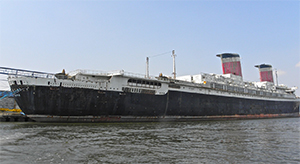 |
|
SS United States was taken out of service in 1969 and has been moored in Philadelphia for nearly 20 years. Last fall, Crystal Cruises dropped its bid to retrofit “America’s flagship” and return it to sea. |
The ship averaged about 28 knots. “On occasion we bumped it up to 35 knots, but at that speed you began to notice vibration from the propellers,” Sturm said. The ship provided a smooth ride. “It was stable. Unlike the Queen Mary, it didn’t roll much. It didn’t pitch much.”
The engineering crew was under strict orders to avoid contact with paying guests. “We were forbidden to intermingle with passengers,” Sturm said. “We had a lounge and we had our own dining room, and we had our own sports deck that was open to the engineers. It was not unusual to see Burt Lancaster running around the open promenade deck or Billy Graham gazing off into the distance meditating.”
As much as he enjoyed the job, he left United States to get married. “I thought it was a fine job for a single guy,” he said. “But for a married person, I thought it was imposing too much of a burden on the family, especially with the children.” That’s because he worked seven days a week for 11 months and then would have one month off.
Sturm married Ruth Finkernagel on Dec. 26, 1959, four days after he left the ship. He worked for Brooklyn Union Gas Co. and New York Telephone Co., applying to the LIRR. He spent 15 years at the railroad as a planner and project manager, and five at the MTA as assistant director for service planning and assistant director for project engineering. His last job was with STV Inc. doing conceptual design work for the engineering consulting firm, which did a lot of projects for the LIRR and other railroads. He retired at age 75.
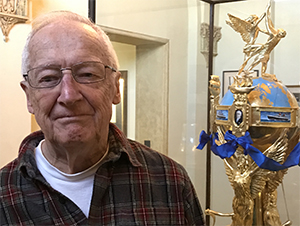 |
|
Sturm poses with the Hales Trophy, awarded to SS United States after its record-breaking maiden voyage in 1952. The ship averaged 34.5 knots as it crossed the Atlantic from New York to Southampton, England. |
Sturm wrote his first two books for the Long Island Sunrise Trail Chapter of the National Railway Historical Society. The New York Connecting Railroad: Long Island’s Other Railroad, written with William G. Thom, was published in 2006. The Long Island Rail Road Company: A History 1834-1965 was published in 2014. He is writing a fourth book, The LIRR in Transition — On the LIRR from 1948 to 1980, covering the period that saw the transfer of ownership from the Pennsylvania Railroad to the state.
When he’s not writing, volunteering at the museum or giving lectures based on his books, Sturm keeps himself busy building models. He’s currently working on a 30-inch model of the Lykes Brothers freighter Reuben Tipton on which he sailed as a midshipman.
Occasionally, Sturm and his wife will take a cruise, but he doesn’t travel much. “When I first got married,” he said, “I had spent four years traveling steadily and didn’t want to go anywhere.”
His time at sea used up all of his wanderlust. It’s the same reason why “I’ve never owned a boat,” he said.
SS United States: The View from Down Below is available by sending a check for $39.95 to Robert Sturm, 27 Pebble Beach Road, Medford, N.Y. 11763.

